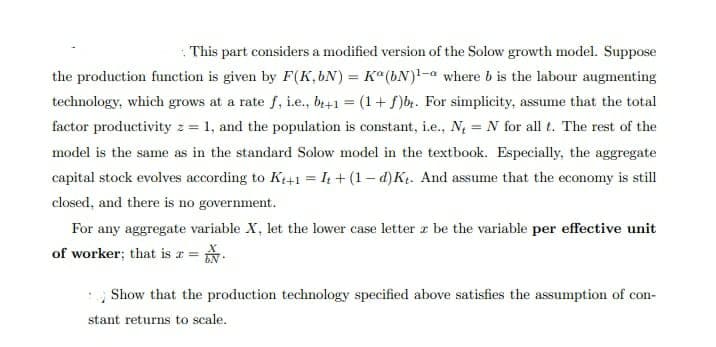.This part considers a modified version of the Solow growth model. Suppose the production function is given by F(K,bN) = K°(bN)!-a where b is the labour augmenting technology, which grows at a rate f, i.e., b41 = (1+ f)b. For simplicity, assume that the total factor productivity z = 1, and the population is constant, i.e., N, = N for all t. The rest of the model is the same as in the standard Solow model in the textbook. Especially, the aggregate capital stock evolves according to K+1 = I1 + (1– d)K. And assume that the economy is still closed, and there is no government. For any aggregate variable X, let the lower case letter r be the variable per effective unit of worker; that is r = . Show that the production technology specified above satisfies the assumption of con- stant returns to scale.
.This part considers a modified version of the Solow growth model. Suppose the production function is given by F(K,bN) = K°(bN)!-a where b is the labour augmenting technology, which grows at a rate f, i.e., b41 = (1+ f)b. For simplicity, assume that the total factor productivity z = 1, and the population is constant, i.e., N, = N for all t. The rest of the model is the same as in the standard Solow model in the textbook. Especially, the aggregate capital stock evolves according to K+1 = I1 + (1– d)K. And assume that the economy is still closed, and there is no government. For any aggregate variable X, let the lower case letter r be the variable per effective unit of worker; that is r = . Show that the production technology specified above satisfies the assumption of con- stant returns to scale.
Linear Algebra: A Modern Introduction
4th Edition
ISBN:9781285463247
Author:David Poole
Publisher:David Poole
Chapter7: Distance And Approximation
Section7.3: Least Squares Approximation
Problem 33EQ
Related questions
Question
please type

Transcribed Image Text:This part considers a modified version of the Solow growth model. Suppose
the production function is given by F(K,bN) = K°(bN)1-a where b is the labour augmenting
technology, which grows at a rate f, i.e., b+1 = (1+f)b. For simplicity, assume that the total
factor productivity z = 1, and the population is constant, i.e., N = N for all t. The rest of the
model is the same as in the standard Solow model in the textbook. Especially, the aggregate
capital stock evolves according to Kt+1 = 4 + (1– d)Kt. And assume that the economy is still
closed, and there is no government.
For any aggregate variable X, let the lower case letter z be the variable per effective unit
of worker; that is r = .
Show that the production technology specified above satisfies the assumption of con-
stant returns to scale.
Expert Solution
This question has been solved!
Explore an expertly crafted, step-by-step solution for a thorough understanding of key concepts.
Step by step
Solved in 3 steps with 1 images

Recommended textbooks for you

Linear Algebra: A Modern Introduction
Algebra
ISBN:
9781285463247
Author:
David Poole
Publisher:
Cengage Learning

Algebra & Trigonometry with Analytic Geometry
Algebra
ISBN:
9781133382119
Author:
Swokowski
Publisher:
Cengage

Linear Algebra: A Modern Introduction
Algebra
ISBN:
9781285463247
Author:
David Poole
Publisher:
Cengage Learning

Algebra & Trigonometry with Analytic Geometry
Algebra
ISBN:
9781133382119
Author:
Swokowski
Publisher:
Cengage